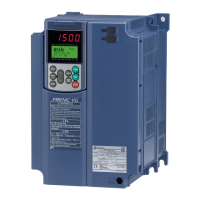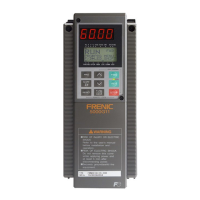6-13
Chap. 6 TROUBLESHOOTING
[ 8 ]
0h2
External alarm
Problem External alarm was inputted (THR).
(when the "Enable external alarm trip" THR has been assigned to any of digital input terminals)
Possible Causes What to Check and Suggested Measures
(1) An alarm function of external
equipment was activated.
Check the operation of external equipment.
Î Remove the cause of the alarm that occurred.
(2) Wrong connection or poor
contact in external alarm signal
wiring.
Check if the external alarm signal wiring is correctly connected to the terminal to
which the "Enable external alarm trip" terminal command THR has been assigned
(Any of E01 through E07, E98, and E99 should be set to "9.").
Î Connect the external alarm signal wire correctly.
Check whether the "Enable external alarm trip" terminal command THR has been
assigned to an unavailable terminal (with E01 through E07, E98, or E99).
Î Correct the assignment.
(3) Incorrect setting of function
code data.
Check whether the normal/negative logic of the external signal matches that of the
THR command specified by any of E01 through E07, E98, and E99.
Î Ensure the matching of the normal/negative logic.
[ 9 ]
0h3
Inverter internal overheat
Problem Temperature inside the inverter has exceeded the allowable limit.
Possible Causes What to Check and Suggested Measures
(1) The surrounding temperature
exceeded the inverter's
specification limit.
Measure the surrounding temperature.
Î Lower the temperature around the inverter (e.g., ventilate the panel where the
inverter is mounted).
[ 10 ]
0h4
Motor protection (PTC/NTC thermistor)
Problem Temperature of the motor has risen abnormally.
Possible Causes What to Check and Suggested Measures
(1) The temperature around the
motor exceeded the motor's
specification range.
Measure the temperature around the motor.
Î Lower the temperature.
(2) Cooling system for the motor
defective.
Check if the cooling system of the motor is operating normally.
Î Repair or replace the cooling system of the motor.
(3) Overload. Measure the output current.
Î Reduce the load (e.g. Use the heat sink overheat early warning (E01 through
E07) or the overload early warning (E34) and reduce the load before the
overload protection is activated.). (In winter, the load tends to increase.)
Î Lower the temperature around the motor.
Î Increase the motor sound (Carrier frequency) (F26).
(4) The activation level (H27) of
the PTC thermistor for motor
overheat protection was set
inadequately.
Check the PTC thermistor specifications and recalculate the detection voltage.
Î Modify the data of function code H27.
(5) Settings for the PTC/NTC
thermistor are improper.
Check the setting of the thermistor mode selection (H26) and the slider position of
terminal [C1] property switch SW5.
Î Change the H26 data in accordance with the thermistor used and set the SW5 to
the PTC/NTC position.
(6) Excessive torque boost
specified. (F09*)
Check whether decreasing the torque boost (F09*) does not stall the motor.
Î If no stall occurs, decrease the F09* data.
(7) The V/f pattern did not match
the motor.
Check if the base frequency (F04*) and the rated voltage at base frequency (F05*)
match the values on the motor's nameplate.
Î Match the function code data with the values on the motor's nameplate.
(8) Incorrect setting of function
code data.
Although no PTC/NTC thermistor is used, the thermistor mode is enabled (H26).
Î Set the H26 data to "0" (Disable).

